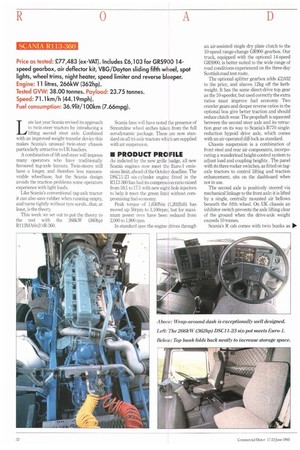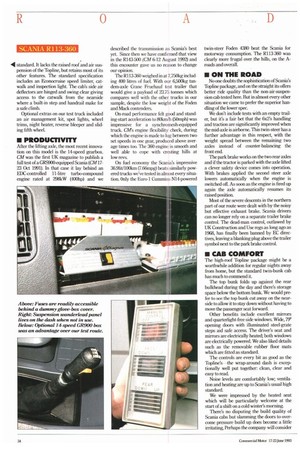L ate last year Scania revised its approach to twin-steer tractors
Page 34

Page 36

Page 37

If you've noticed an error in this article please click here to report it so we can fix it.
by introducing a lifting second steer axle. Combined with an improved weight transfer device this makes Scania's unusual twin-steer chassis particularly attractive to UK hauliers.
A combination of lift and steer will impress many operators who have traditionally favoured tag-axle layouts. Twin-steers still have a longer, and therefore less manoeuvrable wheelbase, but the Scania design avoids the traction problems some operators experience with light loads.
Like Scania's conventional tag-axle tractor it can also save rubber when running empty, and turns tightly without tyre scrub...that, at least, is the theory.
This week we set out to put the theory to the test with the 268kW (360hp) R113MA6x2/4R-360. Scania fans will have noted the presence of Streamline wheel arches taken from the full aerodynamic package. These are now standard on all tri-axle tractors which are supplied with air suspension.
• PRODUCT PROFILE
As indicted by the new grille badge, all new Scania engines now meet the Euro-1 emissions limit, ahead of the October deadline. The DSC11-23 six-cylinder engine fitted in the R113-360 has had its compression ratio raised from 16:1 to 17:1 with new eight-hole injectors to help it meet the green limit without compromising fuel economy.
Peak torque of 1,630Nm (1,2021bft) has moved up 50rpm to 1,100rpm, but for maximum power revs have been reduced from 2,000 to 1,900 rpm.
In standard spec the engine drives through an air-assisted single dry plate clutch to the 10-speed range-change GR900 gearbox. Our truck, equipped with the optional 14-speed GRS900, is better suited to the wide range of road conditions experienced on the three-day Scottish road test route.
The optional splitter gearbox adds £2,032 to the price, and shaves 12kg off the kerbweight. It has the same direct-drive top gear as the 10-speeder, but used correctly the extra ratios must improve fuel economy. Two crawler gears and deeper reverse ratios in the optional box give better traction and should reduce clutch wear. The propshaft is squeezed between the second steer axle and its retraction gear on its way to Scania's R770 singlereduction hypoid drive axle, which comes with an air-operated diff-lock as standard.
Chassis suspension is a combination of front steel and rear air components, incorporating a wanderlead height-control system to adjust load and coupling heights . The panel with its three rocker switches, as fitted on tagaxle tractors to control lifting and traction enhancement, sits on the dashboard when not in use.
The second axle is positively steered via mechanical linkage to the front axle: it is lifted by a single, centrally mounted air bellows beneath the fifth wheel. On UK chassis an inhibitor switch prevents the axle lifting clear of the ground when the drive-axle weight exceeds 10 tonnes.
Scania's R cab comes with twin bunks as standard. It lacks the raised roof and air suspension of the Topline, but retains most of its other features. The standard specification includes an Econocruise speed limiter, catwalk and inspection light The cab's side air deflectors are hinged and swing clear giving access to the catwalk from the nearside where a built-in step and handrail make for a safe climb.
Optional extras on our test truck included an air management kit, spot lights, wheel trims, night heater, reverse bleeper and sliding fifth wheeL
II PRODUCTIVITY
After the lifting axle, the most recent innovation on this model is the 14-weed gearbox. CM was the first UK magazine to publish a full test of a GRE000-equipped Scania (CM 1723 Oct 1991). In that case it lay behind an EDC-controlled 11-litre turbo-compound engine rated at 298kW (400hp) and we
described the transmission as Scania's best yet. Since then we have confirmed that view in the R143-500 (CM 6-12 August 1992) and this encounter gave us no reason to change Our opinion.
The R113-360 weighed in at 7,750kg including 400 litres of fuel. With our 6,500kg tandem-axle Crane Fruehauf test trailer that would give a payload of 23.75 tonnes which compares well with the other trucks in our sample, despite the low weight of the Foden and Mack contenders.
On-mad performance felt good and standing-start aarkTation to 80km/h (50mph) was impressive for a synchromesh-equipped truck. CM's engine flexibility check, during which the engine is made to lug between two set speeds in one gear, produced above average firms too. The 360 engine is smooth and well able to woe with casting hills at low revs.
On fuel economy the Scania's impressive 36.91it/100km (7.66mpg) beats similarly powered trucks we've tested in almost every situation. Only the Euro1 Cununins N14-powered twin-steer Foden 4380 beat the Scania for motorway consumption. The R113-360 was clearly more frugal over the hills, on the Aroads and overall.
• ON THE ROAD
No one doubts the sophistication of Scania's 'confine package, and on the straight its offers better ride quality than the non-air-suspension cab tested here. But in almost every other situation we came to prefer the superior handling of the lower spec.
We don't include tests With an empty trailer, but it's a fair bet that the 6x2's handling and traction are significantly improved when the mid-axle is airborne. This twin-steer has a further advantage in this respect, with the weight spread between the remaining two axles instead of counter-balancing the fmnt cmd.
The park brake works on the two rear axles and if the tractor is parked with the axle lifted a clever safety device comes into operation. With brakes applied the second steer axle lowers automatically when the engine is switched off. As soon as the engine is fired up again the axle automatically resumes its raised position.
Most of the severe descents in the northern part of our route were dealt with by the noisy but effective exhaust brake. Scania drivers can no longer rely on a separate trailer brake contmL The dead-man control, outlawed by UK Construction and Use regs as long ago as 19% has finally been banned by EC directives, leaving a blanking plug above the trailer symbol next to the park brake controL
• CAB COMFORT
The high-roof Topline package might be a worthwhile addition for regular nights away from home, but the standard twin-bunk cab has much to commend it The top bunk folds up against the rear bulkhead during the day and there's storage space below the bottom bunk. We would prefer to see the top bunk cut away on the nearside to allow it to stay down without having to move the passenger scat forward.
Other benefits include excellent mirrors and quarterlight-free side windows. Wide, 79° opening doors with illuminated steel-grate steps aid safe access. The driver's seat and mirrors are electrically heated; both windows are electrically powered. We also liked details such as the removable rubber floor mats which are fitted as standard
The controls are every bit as good as the Topline's the wrap-around dash is exceptionally well put together clean, clear and easy to read.
Noise levels are comfortably low; ventilation and heating are up to Scania's usual high standard.
We were impressed by the heated seat which will be particularly welcome at the start of a shift on a cold winter's morning There's no disputing the build quality of Scania cabs but slamming the doors to overcome pressure build up does become a little irritating Perhaps the company will consider powered door locks which are appearing on some large cars. No doubt the reduction in noise would also be welcomed by anyone living next to night delivery points.
• SUMMARY You don't get owl for nowt the list price of this R113-360, unequipped and devoid of extras, is £71,380. Like the rest of the importers, Scania's prices were forced up last year when sterling chopped out of the Exchange Rate Mechanism and was devalued. Scania (GB) claims its whole life costs to be among the lowest in the industry, in which caw the list price is reduced to a question of cash flow or finance cvsls. But discounts aren't as big as they used to be.
The most obvioirs factor in running casts is fuel consumption, and in this area the Scania extxls, beating the OppOS111011 ov every type of running with an overa that puts it firmly at the head of tl Servicing intervals also play their p there's a hefty 45,000km between '114' services.
This, in addition to the nine hours for test preparation, implies only 15 workshop time during its first yea road (CM's comparison charts assli tractors cover12),000kin a year).
The centre lift axle answers ma cisms levelled at twin-steers. It may n simplest or chempt.st of solutions, handling, braking and load distributir areas whentwin-steers out-perfor The lift facility simply makes then more useable.
1_1 by Danny Coughlan
















































































